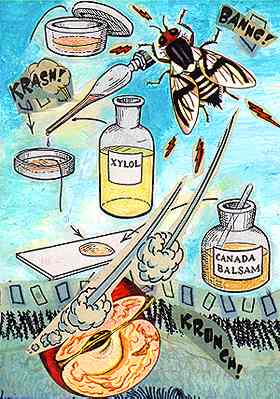
In the movie Scarface, drug lord Tony Montana called cocaine addicts "cock-a-roaches." Researchers at the University of Virginia call them "fruit flies."
UVA biology professor Jay Hirsch and a team of graduate students have spent the last few years distributing freebase to unsuspecting Drosophilia melanogaster (the famed fruit fly of genetics textbooks) and kicking back to watch the fun. Recently they have discovered that fruit flies who lack circadian rhythm, an internal sense of time, do not get addicted to cocaine, possibly because they can't tell how long it's been since they last got high.
While many humans would French-kiss Boris Yeltsin to be a subject in a cocaine experiment, coke research is usually a one way ticket to hell for Drosophilia. "Mortality is likely due to getting squashed between [experiments], a hazard if you're a fly," says Hirsch. Other flies take the Richard Pryor route, as they kamikaze themselves into the heating element of the freebase unit and get fried. Actual cocaine poisoning is rare, but Hirsch admits "the one time we used confiscated street drug, it killed them dead in no time."
In the laboratory, Hirsch and his crew repeatedly exposed fruit flies to 75-100 micrograms of freebased cocaine, with an estimated resale street value of one cent. It turns out that fruit fly cocaine behavior is not very different from that displayed by humans. Once high, the flies exhibited hyperactivity, excessive grooming activity (though not including the purchase of lots of heavy gold chains), and repeated twirling, mostly while listening to Gloria Gaynor's "I Will Survive."
In most animals, time sense is handled by genes with names like clock, cycle, and timeless. Mutant flies without the time-sense genes did not sensitize themselves to repeated doses of freebase, and therefore had a much lower likelihood of addiction. Hirsch admits that he's "not yet clear" as to how this works, but since circadian rhythm is found in nearly all animals, it is possible that the same cocaine regulatory function may also exist in humans. "In the long run," he says, "this research may lead to better treatments for addictions."
Meanwhile, in La Jolla, California, other scientific researchers are mainlining large doses of Mama Coca into rats to try a different weapon against addiction. Dr. Kim Janda's team at The Scripps Research Institute has developed what they believe to be a cocaine 'vaccine.'
Janda's rats do not freebase. They either get their cocaine shot into their jugular vein in a saline solution, or skin-popped through the lining of their abdomen. Once high, they do the normal "rats high on cocaine" thing; autistic-like self-stimulation, and sniffing (not cocaine). The doctor did not mention slither-by shootings.
To create the vaccine, Janda attached a simple biological protein to a derivative of cocaine and injected it into his rats. Once in the bloodstream, the rat's immune system makes antibodies against the cocaine-protein combination. The next time the rat is exposed to cocaine, the un-coke antibodies surround the drug molecules and prevent them from entering the brain.
Janda hopes to begin clinical tests of the vaccine on humans late in 2000. Line up early.
Patrick Di Justo expects other people to be interested in the minutiae of his daily life.
